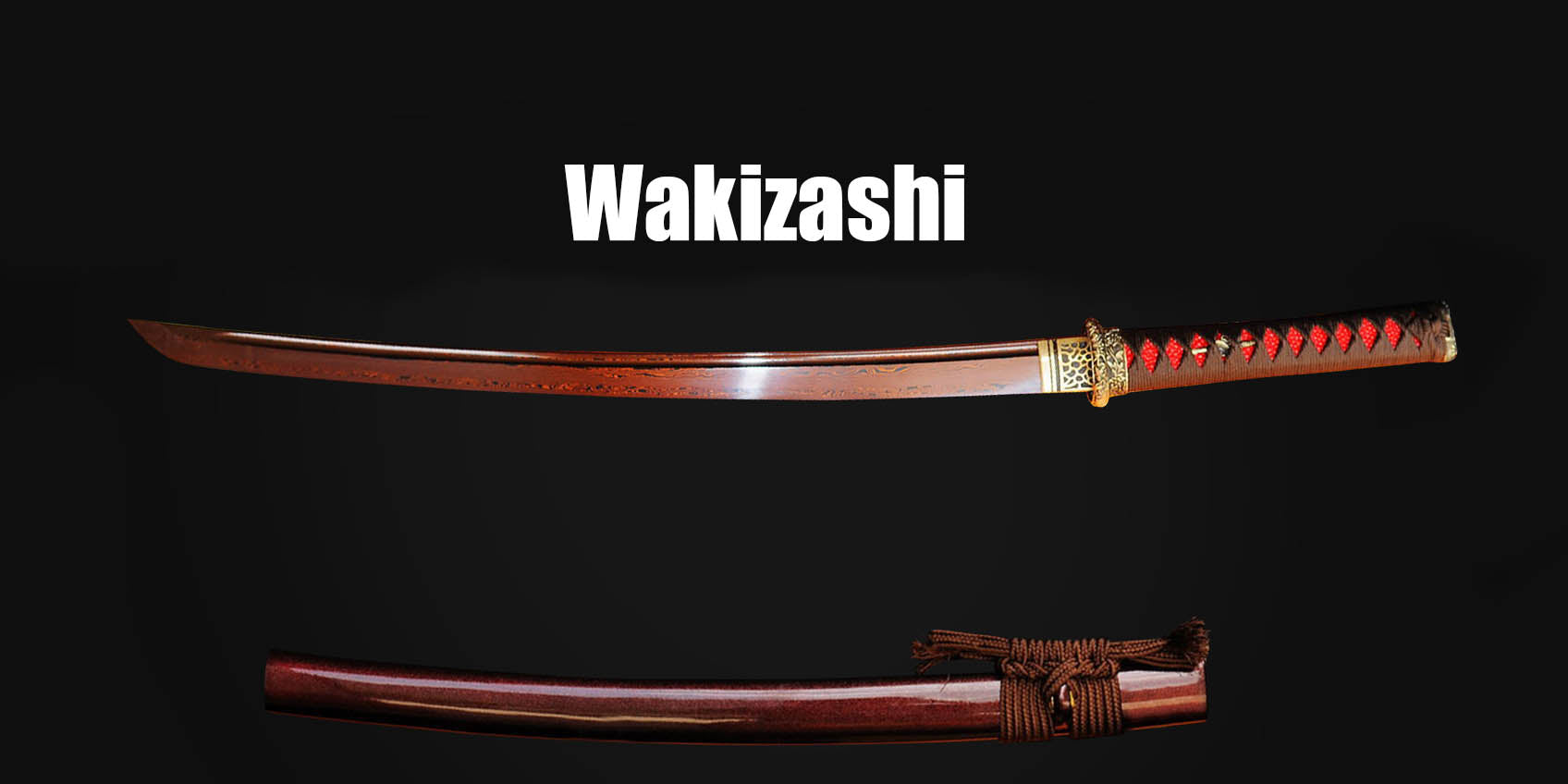How to Use a Katana Sword: Secrets & Techniques Revealed by Wakizash

mong the world’s cold weapons, Japanese swords are renowned globally for their elegant curves and superb craftsmanship. When it comes to katana sword types, most people first think of the long, curved, and iconic Katana. However, as an essential member of the samurai sword system, the short sword Wakizashi also plays an indispensable role and is a key to understanding Japanese sword culture.
This article focuses on the Wakizashi, combining the background of types of samurai sword to analyze its historical significance, structural features, and usage methods, helping you gain a comprehensive understanding of this blade that holds a special place in the life of the Japanese samurai.
1. The Samurai Sword System: What Swords Did Samurai Use?
A samurai’s combat equipment was not limited to just one long sword. Traditionally, they carried three types of blades, known as the what are the 3 samurai swords called — the system of 'two swords and a dagger':
-
Katana: The main weapon of war, long and curved, suitable for fast drawing and slashing.
-
Wakizashi: A short sword between the Katana and Tanto in length, used for indoor defense and ceremonial purposes.
-
Tanto: A small dagger often used for self-defense or sudden attacks.
These three blades together are called the 'samurai’s three swords,' which not only symbolize the samurai’s identity but also meet different combat and ceremonial needs.
2. The History and Function of Wakizashi — An Important Member among Types of Katanas
As one of the many different katanas, the Wakizashi occupies an irreplaceable position in the Japanese samurai sword system due to its unique size and versatile uses. Usually between 30 to 60 cm long, it sits between the Katana and Tanto, sometimes referred to as the 'Wakizashi sword.'
1. Wearing Method: A Double-Edged Sword of Identity and Ceremony
Samurai typically wore the long Katana at their waist, blade facing upward for quick drawing in battle; however, when entering indoors or formal occasions, samurai would remove the Katana and wear only the Wakizashi to show respect and adhere to etiquette. This habit not only allowed samurai to move flexibly in confined spaces but also reinforced the Wakizashi’s symbolic importance among japanese blade weapons.
Furthermore, the combination of Wakizashi and Katana is called “daisho” (big and small swords), representing samurai status and rank. Ordinary civilians were not allowed to carry the daisho, so wearing a Wakizashi was, to some extent, a symbol of social class and honor.
2. Tactical Value: Short, Agile, and Versatile
In terms of combat practicality, the compact size of the Wakizashi makes it ideal for close-quarters fighting and defense. Compared to the long sword, it is easier to draw quickly and wield flexibly in narrow spaces, capable of swift stabbing and cutting.
Additionally, Wakizashi was often used in ceremonial seppuku (Harakiri), a solemn and serious ritual, reflecting its cultural and spiritual significance.
When samurai were attacked indoors, using a Wakizashi for defense was a common tactical choice; it was the most practical secondary weapon, combining offensive and defensive versatility.
3. Artistic Value: The Perfect Blend of Blade and Decoration
Beyond practicality, the Wakizashi’s artistic value should not be overlooked. As a representative of katana blade types, Wakizashi blades were often forged and clay-tempered with meticulous care, displaying unique Hamon patterns that demonstrate the craftsman’s superb skill.
Its scabbard (Saya) and hand guard (Tsuba) were not only functional but also carriers of artistic craftsmanship. Many Wakizashi scabbards and guards were engraved with famous katana names and katana nicknames, such as the legendary “Onikiri” and “Hime Tsuru.” These names endowed the blades with unique historical stories and spirit, reflecting the personality and family heritage of the wielder.
Moreover, many collectors and connoisseurs especially favor the Wakizashi because it combines exquisite appearance with deep cultural meaning, making it a masterpiece of Japanese sword art.
3. Structural Analysis of Wakizashi — A Microcosm of the Parts of a Katana
Understanding the construction of the Wakizashi helps with proper use and appreciation:
-
Tsuka (Handle): Wrapped with ray skin, providing a firm grip suitable for quick maneuvers.
-
Tsuba (Guard): Protects the hands and serves as an artistic element.
-
Saya (Scabbard): Made of high-quality lacquered wood to protect the blade.
-
Hamon (Tempered Edge Pattern): The clay tempering process creates distinctive patterns that symbolize quality and aesthetic appeal.
These parts of a katana are reflected in the Wakizashi, whose blade is lightweight yet durable, fulfilling the dual requirements of sharpness and portability demanded by the 'samurai sword.'
4. Comparing Wakizashi with Other Japanese Blades — A Complete Guide to Different Kinds of Katanas
Wakizashi vs Katana
-
Katana has a longer blade, suitable for outdoor combat;
-
Wakizashi is shorter, better suited for indoor and close-range fighting;
-
The two are often used together as the daisho system.
Wakizashi vs Tanto
-
Tanto is dagger-like, primarily for self-defense;
-
Wakizashi is more versatile, suitable for both combat and ceremony.
Wakizashi vs Other Traditional Weapons — Naginata vs Others
-
Naginata is a pole weapon with long reach, often used by female warriors (female naginata).
-
Compared to the Naginata, Wakizashi is more lightweight and agile.
-
Nowadays, wooden naginata for sale are popular among martial arts practitioners.
Hand Forged Japanese Wakizashi Sword Folded Steel Brass Tsuba Reddish Black Blade
5. How to Properly Use a Wakizashi — Practical Guidance on How to Use a Katana Sword
As an important member among types of katanas, the short and flexible Wakizashi requires usage techniques different from those of the Katana. Mastering correct methods not only maximizes combat effectiveness but also better reflects the samurai’s refined understanding of katana styles.
1. Grip
When using the Wakizashi, grip technique on the handle (Tsuka) is critical. Both hands should alternately hold naturally, keeping fingers flexible without excessive force to ensure the sword does not slip during fast draws. Compared to the Katana, the Wakizashi’s shorter size demands more precise control and agile wrist movements for versatile offense and defense.
2. Drawing the Sword
The drawing motion should be swift and smooth, combined with body weight shifts to maximize speed and power. Since the Wakizashi is often used indoors or in close combat, quick drawing is usually the key to gaining the upper hand. Proper drawing also avoids losing balance from stiff movements, reflecting traditional samurai blade training.
3. Cutting Techniques
Wakizashi is suitable for short-distance cutting and stabbing, perfect for rapid thrusts, horizontal slashes, and counterattacks. Due to its shorter blade, movements should be more agile and varied, coordinated with footwork to form a flexible offense. Familiarity with katana blade types and blade angles is particularly important to improve precision and lethality.
4. Defense
The Wakizashi’s mobility makes it excellent for defense. Its flexibility allows effective blocking of enemy attacks followed by swift counterstrikes. Blocking should be combined with adjusting body balance to maintain stability. Learning various katana styles enables more diverse and layered defensive tactics.
Mastering the use of Wakizashi not only demonstrates the samurai’s deep understanding of various types of samurai sword but also allows them to move with ease in complex battlefield conditions. Whether for combat or cultural heritage, Wakizashi is an indispensable weapon.
6. Wakizashi Weight and Craftsmanship — How Much Does a Katana Weigh & How Are Katanas Made
Wakizashi typically weighs between 0.5 to 1 kilogram, much lighter than the Katana. In terms of craftsmanship, traditional Japanese swords follow these steps:
-
Repeatedly forged and folded carbon steel to remove impurities;
-
Clay tempering (clay tempering) to create a blade edge that is both hard and resilient;
-
Hand polishing to produce sharp Hamon patterns;
-
Finally, mounting the handle and guard to ensure overall balance and feel.
Each Wakizashi embodies the wisdom of the craftsman, perfectly blending function and artistry.
Conclusion
As an indispensable member of the samurai sword system, the Wakizashi combines practicality, cultural significance, and artistry. Whether as a collectible or a practice blade, it reflects the deep heritage of Japanese sword culture and the spirit of the samurai.
If you are interested in samurai sword name, different katanas, or want to learn more about katana sword types, stay tuned. We will continue to bring you authoritative and detailed introductions and usage guides on Japanese swords.









